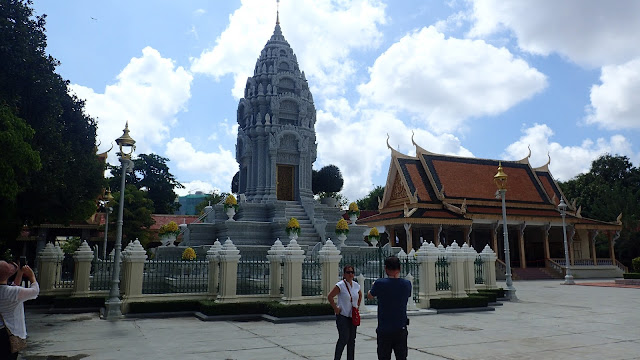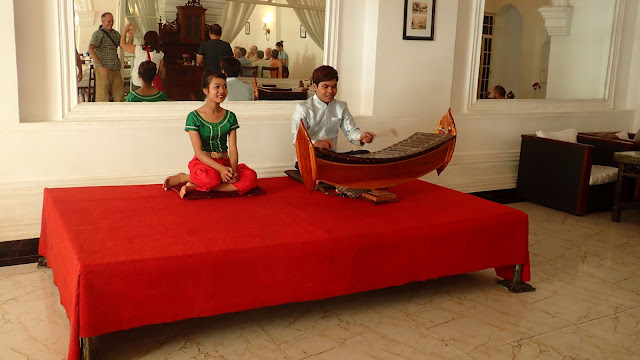We watched a young girl, maybe 3 years old as she made her way down the concrete embankment of the Tonle Sap all alone. When she got down to the water, she stood patiently near a boat that was tethered to the embankment. It took about five minutes, and then a man came out from under the cover and used the tether to pull the boat over to the little girl. She then climbed onto the boat (without any help), and crawled under the cover. When we looked closely, we could see her under the cover taking care of a baby that was in a hammock. Kids grow up fast here, probably because they have to. It's amazing and humbling for us to watch.
Once we met up with our group, we met our tour director Khanh and our Cambodian guide for the day Sophea and then crawled into our bus and made our way through town.
We love exploring cities on our own, but to see all of the touristy sights in an easy and convenient way, a tour is great. We found out that the temple we can see from our hotel window was built in 1443. We also found out that the Mekong River runs from Laos to Vietnam and then into the China Sea.
We drove by the Victory Monument, dedicated to Cambodia's independence from the French; it now also serves as a memorial to Cambodia's war victims. Unfortunately, Steve and I couldn't see it because we were on the wrong side of the bus (a down side of tours), but tomorrow, November 9th, is independence day in Cambodia, so it will be a big celebration at the monument.
Next, we visited the royal palace, built by King Norodom in 1917 on the site of the old town. The grounds of the palace are beautiful, and are 431 meters by 435 meters. It is important to remember that in all Buddhist palaces, temples and pagodas it is important to cover your knees and shoulders.
The current king lives in the palace compound and is a 64 year old bachelor. We were allowed to peek into the palace, but no pictues were allowed.
The building in the background is the residence of the king. There is a blue flag that flies anytime he is at the residence.
 |
| You can see the blue flag on the far right of this photo |
Other national treasures housed here include a solid gold and jeweled Buddha statue made from 90 kilos of 24k gold and a small 17th century Baccarat crystal Buddha, known as the "Emerald Buddha". They are both very ornate and beautiful, but no pictures were allowed.
Unfortunately, no pictures are allowed within many of the buildings on the palace grounds, but we had a little fun taking some pictures outside of the buildings.
Formal wear of the king and queen can be worn by brides and grooms on their wedding day, and is housed in a building near the palace.
Formal wear of the royal guards.
A beautiful mural on the palace gounds that was originally painted in 1903 and completed in 1904 by 40 consecutive artists. It was recently restored by the government.
The blossoms in this tree open in the morning and are dead by evening. They are gorgeous, but you better pay attention if they are blooming.
 |
| Totally rocking the tourist look! |
When we finished our tour of the royal palace, we continued through town to the Tuol Sleng Genoside Museum. This museum is on the site of a former high school used as the notorious Security Prison 21 (S-21) by the Khmer Rouge regime.
Near the end of the Vietnam war, a group of communist rebels in Cambodia, lead by an individual known as Pol Pot, took advantage of the unrest in the surrounding countries to start an uprising in their own country. They became known as the Khmer Rouge.
The Khmer Rouge was a brutal, murderous revolutionary group intent on revolutionizing Cambodia. Their plan was to deconstruct Cambodia, removing all Western innovations, and requiring all citizens to participate in rural work projects. In order to accomplish this, they planned to eliminate all intellectual people.
Khmer Rouge soldiers were young peasants from the provinces, mostly uneducated teenage boys who had never been in a city before. The Khmer Rouge was small at first, but new people were constantly being recruited. Many Cambodians had become disenchanted with their government due to the huge loss of lives from Cambodia's involvement in the Vietnam War and were driven to join Pol Pot’s Khmer Rouge guerrilla movement. By 1975, Pol Pot’s force had grown to over 700,000 men.
On Aril 17th, 1975, the communist Khmer Rouge Army marched into Phnom Penh and took over the city. The prince was taken first, and he told all of the city's residents to cooperate with the regime, hoping that they would be spared if they did. The regine forced all of the residents to leave behind all of their belongings and leave the city immediately, so they attempted to smuggle a few valuables out with them and fled to the outlying villages.
Once Khmer Rouge had control of the city, they would visit the villages, and take the educated people and their families one by one back into the city, where they were imprisoned and accused of horrible crimes. They were held in cells and tortured endlessly until they admitted to the crimes they were being accused of, (even if they had not ever done what they were accused of) then they would be sent to the killing fields where they would die a slow painful death.
Our tour guide Sophea is the only one from her family of seven who survived the Khmer Rouge. Her family was taken from the village one by one, being told that they were being sent to town for education. But the village people finally figured out this wasn't true because no one ever returned. Our tour guide survived because she hid on the roof each time the Khmer Rouge would come into the village so they didn't know she was there. She was 11 at the time the seige started, and 14 when it finally ended. The seige of the Khmer Rouge lasted for 3 years, 8 months and 20 days. The city was finally taken back with the help of the Vietnamese army.
The Genoside Museum is now housed in the notorious Prison 21. It consists of 4 buildings.
Building A was three stories, divided into 20 cells. The first floor had 10 cells, the second and third floors had five big cells each. Building A was used for jailing, interrogating and torturing the prisoners who had been the high officials before the takeover. They were considered traitors by the regime. Buildings B, C and D housed the ordinary people that were brought back from the villages. A lot of evidence remains in all of the cells of the atrocities committed by Pol Pot and the Khmer Rouge.

When this was still a high school before the takeover, this pole with cables attached had been used for the students to exercise. The Khmer Rouge used it as an interrogation area.
The interrogators tied both hands of the prisoners behind their back with a rope and lifted the prisoners upside down. They did this until the prisoners lost consciousness. Then they dipped the prsioner's head into a pot of smelly, filthy water normally used as fertilizer for the crops on the terrace. By doing this, the victims quickly regained consciousness and the interrogations could continue.
The entire experience at the Genocide Museum was very difficult to witness. After seeing this small portion of the display, we felt that we had seen enough, and opted to grab a seat and just reflect on this atrocity.
Although this is a very difficult time in history to relive in our thoughts, I think it is extremely important to keep these types of museums as a reminder of terrible events so that we can learn from the past and maybe prevent them from ever happening again.
There is a lot more information available for this period of history. I encourage everyone to take the time to understand it more fully.
Once we left the Genocide Museum and regained our composure a bit, we had lunch together at the Phkar Romyool Cafe and Restaurant in the Le Grand Palais Boutique Hotel.

It was set up very nicely and could easily accommodate a group for lunch.
 |
| Shenanigans at the lunch table |
 |
| Banana blossom salad |
 |
| Khmer hot and sour fish soup |
 |
| Stir fried beef with peppers |
 |
| Fresh fruit for dessert |
In the restaurant lobby, they had musicians and dancers to entertain us while we enjoyed our lunch.
After lunch we took a quick walk, and I noticed a scene that I thought was totally representative of Cambodia, so I had to take a picture. The fruit cart on the right. The tooth sign up near the top, showing a dental office. Cafe seating on the sidewalk, with a car and motor bikes parked all around. This is something you see on every corner in Cambodia.
There was a wedding at Le Grand Palaise while we were enjoying our lunch, so I quietly crashed the picture session. When we got back to the bus, I asked Khanh and he said that in Cambodia everything is rented for the wedding, including the brides wedding dress.
When we left the Le Grand Palais, we headed to the airport for our short one hour flight to Siem Reap. Although it has been an action packed day, and and we're all a little tired, it's only one in the after noon and we still have half a day ahead of us, so stay tuned for part two of today's activities.






































No comments:
Post a Comment